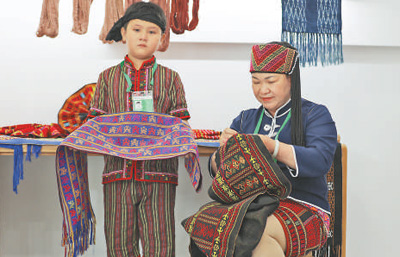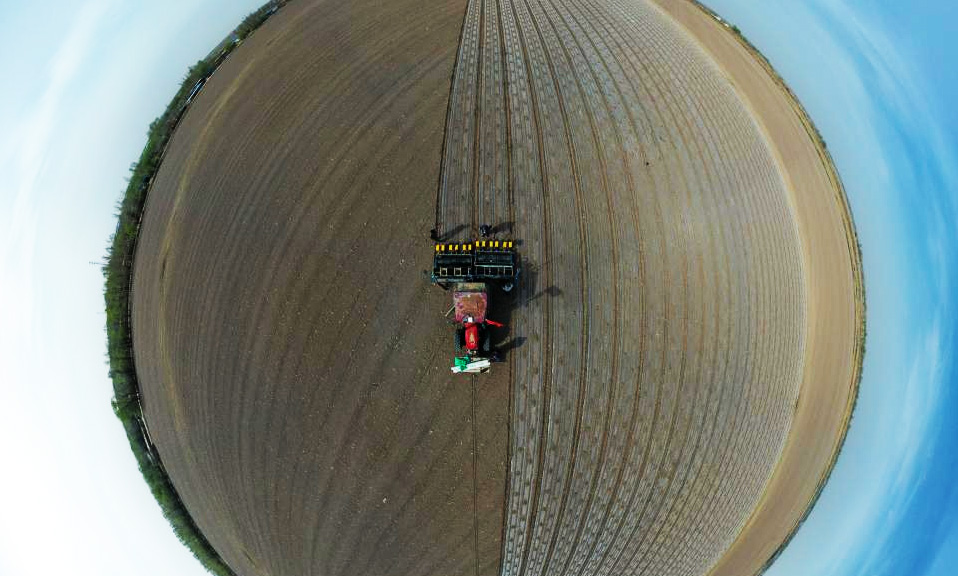Woman devotes decades to passing on traditional ethnic brocade craft in S China’s Hainan
Liu Xianglan, a national representative bearer of the traditional ethnic brocade craftsmanship of the Li ethnic group in south China’s Hainan Province, has dedicated herself to passing on the craft after introducing innovations for more than 40 years, injecting new vitality into the folk art.

Master craftswoman Liu Xianglan and her grandson attend a show to present Li brocade weaving techniques. (Photo courtesy of the convergence media center of Wuzhishan city)
Liu, a resident in Fanmao village, Wuzhishan city of the province, began to learn the Li brocade weaving techniques when she was 13 from her mother. Nowadays, her brocade products find good markets overseas.
According to Liu, the traditional Li textile techniques can be traced back to 3,000 years ago, and involve four steps that include spinning, dyeing, weaving and embroidering. She explained that it usually takes a craftsman at least three or fourth months to finish a handmade Li brocade piece.
Traditionally, blue and black are the main colors used in Li brocade, but now Li brocade is known for its more striking colors, the craftswoman said.
Liu pointed out there are at least 100 kinds of embroidery patterns, which indicate people’s longing for a better life, for Li brocade.
The traditional Li textile techniques have been exposed to the risk of extinction. In the past, the techniques were passed down through the master-apprentice model.
However, Liu thought that the inheritance of the techniques should keep pace with the times.
In 2005, she set up a company and mobilized women in her villager to weave Li brocade. Two years later, she established a Li brocade workshop with the support of relevant government departments and offered free courses on the techniques.
Previously, the Li textile techniques were only passed on to women, but Liu has also taught the techniques to her sons.
By integrating the traditional Li textile techniques with modern technology, Liu has developed cultural and creative products, including handbags, T-shirts and ties.
In June 2009, Liu was named as a national representative bearer of the traditional Li textile techniques of spinning, dyeing, weaving and embroidering. In the same year, the techniques were inscribed on the UNESCO List of Intangible Cultural Heritage in Need of Urgent Safeguarding.
Now the intangible cultural heritage of Li brocade has been revitalized. Wuzhishan city alone is home to more than 2,100 women of the Li ethnic group who are engaged in Li brocade weaving.
“No two Li brocade pieces in the world are identical,” Liu said, adding that innovations are needed to inject more vitality into the traditional craft.
Photos
 World Book Day: Let's read together
World Book Day: Let's read together Rare silver pheasants flock together in greater numbers to forage at Yishan nature reserve in east China's Jiangxi
Rare silver pheasants flock together in greater numbers to forage at Yishan nature reserve in east China's Jiangxi Young artist takes up brush to create lifelike paintings expressing mankind and nature’s harmonious co-existence
Young artist takes up brush to create lifelike paintings expressing mankind and nature’s harmonious co-existence Cutton farming in full swing in China's Xinjiang
Cutton farming in full swing in China's Xinjiang
Related Stories
- Boao Forum for Asia in preparation
- In pics: Wormhole Library in Haikou Bay, S China's Hainan
- Landscape of Boao in S China's Hainan
- Blue-tailed bee eaters seen in Haikou
- Key industrial parks at Hainan Free Trade Port register revenue of 1.36 trillion yuan in 2021
- Hainan gibbons welcome new addition to family living on southern China’s tropical island
- Sound ecological environment brings wealth to local residents in Wuzhishan city in Hainan
- Indefatigable team of women transform barren coastal area of Hainan with largescale tree-planting efforts
- Four years on, Hainan presents new image
- Botany teacher devotes himself to protection of wetland home for waterfowl species in Hainan
Copyright © 2022 People's Daily Online. All Rights Reserved.






